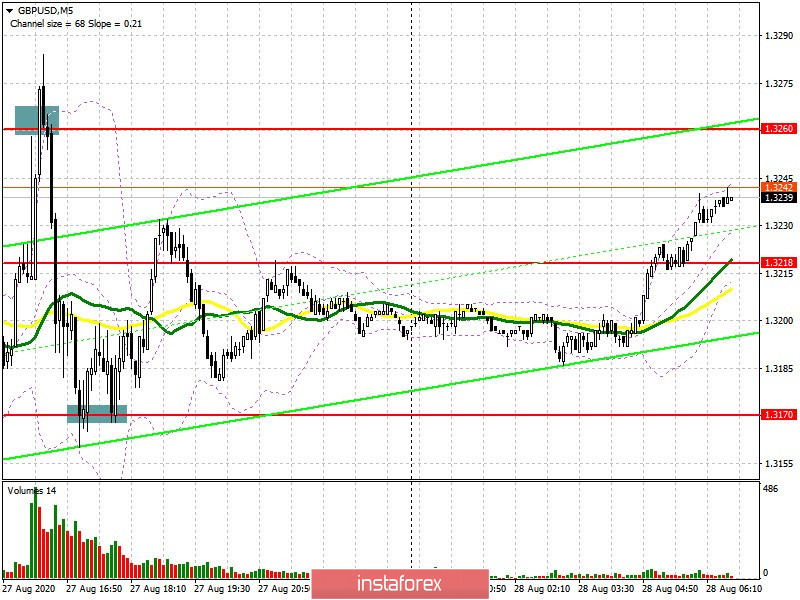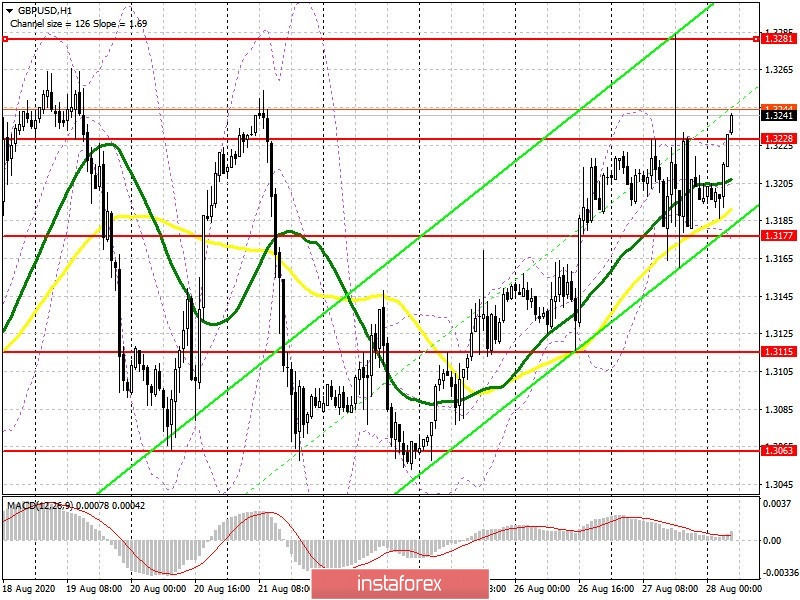To open long positions on GBP/USD, you need:
Federal Reserve Chairman Jerome Powell's recent decision on monetary policy caused buyers of the British pound to make an attempt at growth, which allowed them to renew the August highs, at which they will try to gain a foothold today. As for yesterday's entry points, it was possible to make money on selling the pound – this could be done by more risky traders, as well as on long deals, which made it possible for you to get around 50 points. Let's analyze the entry points. On the 5 minute chart, the pound sharply grew in the resistance area of 1.3260 after Powell's statements, which is where I recommend opening short positions from the rebound. Then, closer to the middle of the US session, when the pair fell to the support area of 1.3170, the bulls achieved a false breakout, which formed a good entry point into long positions. At the moment, focus has shifted to the resistance of 1.3228, settling on which will be a good signal to open long positions in the hope of continuing the growth of GBP/USD to the area of yesterday's high of 1.3281, where I recommend taking profits. The 1.3316 area will be a long-term target. If the bulls do not manage to gain a foothold above the resistance of 1.3228, then it is best not to rush in buying when the pair declines, but wait for the support test of 1.3177, where a false breakout will be a signal to enter the market. If bulls are not active, I recommend opening long positions immediately for a rebound only from a low of 1.3115, counting on a correction of 30-35 points within the day.
You also need to take note of the Commitment of Traders (COT) reports for August 18, which recorded growth in long positions again, as well as the reduction of short ones. The COT report indicates that short non-commercial positions decreased from 59,874 to 47,806 during the week. On the contrary, long non-commercial positions increased from the level of 48,053 to the level of 54,310. As a result, the non-commercial net position became positive and reached 6,504, against – 2,821. This suggests that the market trend has changed and long deals on the pound when it declines become more attractive and interesting from an investment point of view.

To open short positions on GBP/USD, you need:
Bears need to try to prevent a breakout of the 1.3228 resistance, which is so actively prepared by buyers of the pound. An unsuccessful consolidation above this range and returning under it in the morning forms a good entry point for selling the pound in anticipation of a return and decline to the support of 1.3177, where the downward movement may slow down. Settling below this range forms a more powerful bearish wave that can return the pair to the 1.3115 area, where I recommend taking profits. Bank of England Governor Andrew Bailey will deliver a speech this afternoon, which may also negatively affect the growth prospects of the British pound. However, in case sellers are not active at the 1.3228 level, it is best to defer short positions to the months's high in the area of 1.3281, or sell GBP/USD immediately on a rebound from a major new resistance 1.3316 based on the correction of 20-30 points within the day.

Indicator signals:
Moving averages
Trading is carried out above 30 and 50 moving averages, which indicates a continuation of the upward trend for the pound.
Note: The period and prices of moving averages are considered by the author on the H1 hourly chart and differs from the general definition of the classic daily moving averages on the daily D1 chart.
Bollinger Bands
In case of a decline, the pair will be supported by the lower border of the indicator at 1.3175.
Description of indicators
- Moving average (moving average, determines the current trend by smoothing out volatility and noise). Period 50. It is marked in yellow on the chart.
- Moving average (moving average, determines the current trend by smoothing out volatility and noise). Period 30. It is marked in green on the chart.
- MACD indicator (Moving Average Convergence/Divergence — convergence/divergence of moving averages) Fast EMA period 12. Slow EMA period to 26. SMA period 9
- Bollinger Bands (Bollinger Bands). Period 20
- Non-commercial traders are speculators, such as individual traders, hedge funds, and large institutions that use the futures market for speculative purposes and meet certain requirements.
- Long non-commercial positions represent the total long open position of non-commercial traders.
- Short non-commercial positions represent the total short open position of non-commercial traders.
- Total non-commercial net position is the difference between short and long positions of non-commercial traders.





















